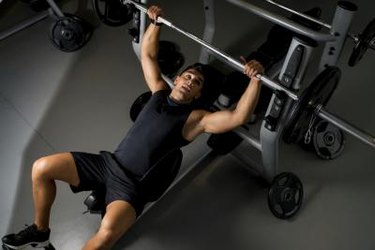
Up until the rise in the popularity of the bench press in the late 1950s, the standard of strength was the press. Pressing a large weight overhead builds the shoulders and triceps, and, performed correctly, recruits a great deal of both upper-body musculature, such as your back. When performed standing, the press will also recruit your lower back and abdominals, which stabilize your torso. Strong shoulders and triceps contribute to a strong bench press. While no exact ratio exists, some standards can apply. Consult a health care provider before beginning any diet or exercise program.
Men's Ratio
Video of the Day
The press is always less than the bench press, if not, then something is seriously wrong with your technique. According to Marke Rippetoe and Lon Kilgore in "Practical Programming," if you are an untrained man the press will be 62.8 percent of your bench press. If you are a novice lifter, your shoulder press will be 67 percent of your bench press. If you are an intermediate lifter, you should press at least 68.8 percent of your flat bench. As an advanced lifter, you should press 59.8 percent of your bench press, and if you are an elite lifter, your shoulder press should be at least 63.5 percent of your bench press.
Video of the Day
Women's Ratio
An untrained woman, on average, will overhead press 62.9 percent of her bench press. If you are a novice woman, you should press approximately 67.1 percent of your bench press. As an intermediate female lifter, you should press 67.5 percent of your flat bench press. When you become an advanced female lifter, you should press at least 69.8 percent of your bench press. An elite female athlete should press at least 73.2 percent of her one repetition maximum on the flat bench. All numbers represent data based on single-repetition efforts, regardless of gender or weight.
Reasons for the Discrepancy
When you are using the flat bench press, your shoulders and torso are stable because the bench is supporting you. When standing, your abdomen and lower back must heavily contract to stabilize your torso when pressing overhead. While the wide muscles of your back are active in both lifts to a degree, the latissimus dorsi, the widest muscles of your back, function not only as part of the initial push but to stabilize your shoulders when pressing overhead. Even the muscles of your upper back must work to stabilize your arms as you push the bar overhead.
Improving the Discrepancy
The muscles used in the press are all used to a degree in the bench press, and the reverse is also true. The supporting muscles simply need to work harder when executing the shoulder press, and this can lead to a greater discrepancy. Improvements in the press will work the muscles that stabilize the torso more than the bench press. Improvements in the bench press will strengthen only some of the muscles used in the shoulder press. So pressing overhead will improve your bench press more than bench pressing will improve your shoulder press.